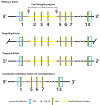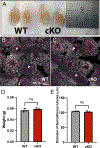Loss of function of male-specific lethal 3 (Msl3) does not affect spermatogenesis in rodents
- PMID: 37847071
- PMCID: PMC11021377
- DOI: 10.1002/dvdy.669
Loss of function of male-specific lethal 3 (Msl3) does not affect spermatogenesis in rodents
Abstract
Background: Male-specific lethal 3 (Msl3) is a member of the chromatin-associated male-specific lethal MSL complex, which is responsible for the transcriptional upregulation of genes on the X chromosome in males of Drosophila. Although the dosage complex operates differently in mammals, the Msl3 gene is conserved from flies to humans. Msl3 is required for meiotic entry during Drosophila oogenesis. Recent reports indicate that also in primates, Msl3 is expressed in undifferentiated germline cells before meiotic entry. However, if Msl3 plays a role in the meiotic entry of mammals has yet to be explored.
Results: To understand, if Msl3a plays a role in the meiotic entry of mammals, we used mouse spermatogenesis as a study model. Analyses of single-cell RNA-seq data revealed that, in mice, Msl3 is mostly expressed in meiotic cells. To test the role of Msl3 in meiosis, we used a male germline-specific Stra8-iCre driver and a newly generated Msl3flox conditional knock-out mouse line. Msl3 conditional loss-of-function in spermatogonia did not cause spermatogenesis defects or changes in the expression of genes related to meiosis.
Conclusions: Our data suggest that, in mice, Msl3 exhibits delayed expression compared to Drosophila and primates, and loss-of-function mutations disrupting the chromodomain of Msl3 alone do not impede meiotic entry in rodents.
Keywords: male‐specific lethal 3 (Msl3); meiosis; meiotic entry; spermatogenesis.
© 2023 American Association for Anatomy.
Conflict of interest statement
Figures






Update of
-
Loss Of Chromodomain of Male-Specific Lethal 3 (MSL3) Does Not Affect Spermatogenesis In Rodents.bioRxiv [Preprint]. 2023 Jun 27:2023.03.16.532933. doi: 10.1101/2023.03.16.532933. bioRxiv. 2023. Update in: Dev Dyn. 2024 May;253(5):453-466. doi: 10.1002/dvdy.669. PMID: 36993289 Free PMC article. Updated. Preprint.
Similar articles
-
Loss Of Chromodomain of Male-Specific Lethal 3 (MSL3) Does Not Affect Spermatogenesis In Rodents.bioRxiv [Preprint]. 2023 Jun 27:2023.03.16.532933. doi: 10.1101/2023.03.16.532933. bioRxiv. 2023. Update in: Dev Dyn. 2024 May;253(5):453-466. doi: 10.1002/dvdy.669. PMID: 36993289 Free PMC article. Updated. Preprint.
-
Conditional ablation of DIS3L2 ribonuclease in pre-meiotic germ cells causes defective spermatogenesis and infertility in male mice.Theranostics. 2024 Sep 3;14(14):5621-5642. doi: 10.7150/thno.98620. eCollection 2024. Theranostics. 2024. PMID: 39310107 Free PMC article.
-
Msl3 promotes germline stem cell differentiation in female Drosophila.Development. 2022 Jan 1;149(1):dev199625. doi: 10.1242/dev.199625. Epub 2022 Jan 4. Development. 2022. PMID: 34878097 Free PMC article.
-
Mechanisms of meiosis initiation and meiotic prophase progression during spermatogenesis.Mol Aspects Med. 2024 Jun;97:101282. doi: 10.1016/j.mam.2024.101282. Epub 2024 May 25. Mol Aspects Med. 2024. PMID: 38797021 Review.
-
Toward understanding the core meiotic transcriptome in mammals and its implications for somatic cancer.Ann N Y Acad Sci. 2007 Dec;1120:1-15. doi: 10.1196/annals.1411.010. Epub 2007 Oct 2. Ann N Y Acad Sci. 2007. PMID: 17911412 Review.
Cited by
-
Tracing Early Migratory Neurons in the Developing Nose Using Contactin-2 (Cntn2) CreERT2.Genesis. 2025 Aug;63(4):e70021. doi: 10.1002/dvg.70021. Genesis. 2025. PMID: 40580015 Free PMC article.
References
-
- Clermont Y 1972. Kinetics of spermatogenesis in mammals: seminiferous epithelium cycle and spermatogonial renewal. Physiol Rev 52:198–236. - PubMed
-
- de Rooij DG. 2001. Proliferation and differentiation of spermatogonial stem cells. Reproduction 121:347–354. - PubMed
-
- Brieno-Enriquez MA, Faykoo-Martinez M, Goben M, Grenier JK, McGrath A, Prado AM, Sinopoli J, Wagner K, Walsh PT, Lopa SH, Laird DJ, Cohen PE, Wilson MD, Holmes MM, Place NJ. 2023. Postnatal oogenesis leads to an exceptionally large ovarian reserve in naked mole-rats. Nat Commun 14:670. - PMC - PubMed
-
- de Rooij DG. 2017. The nature and dynamics of spermatogonial stem cells. Development 144:3022–3030. - PubMed
Publication types
MeSH terms
Substances
Associated data
- Actions
Grants and funding
LinkOut - more resources
Full Text Sources
Molecular Biology Databases
Research Materials

